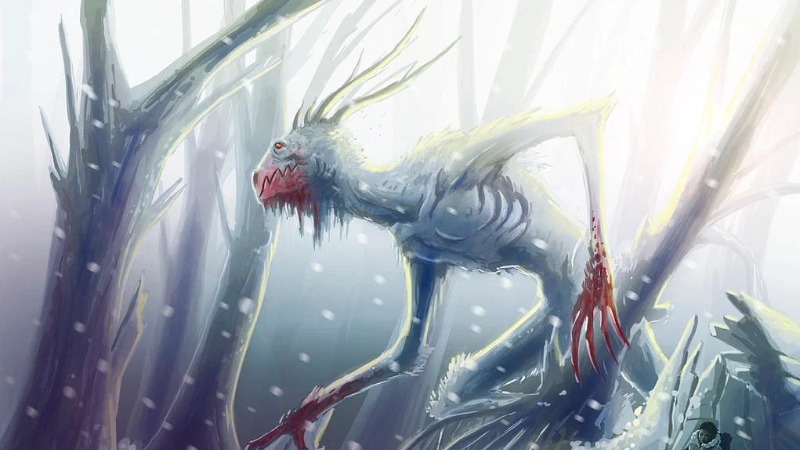The Wendigo originates from the oral traditions of Algonquian-speaking tribes, including the Ojibwe, Cree, and Algonquin peoples. According to these legends, the Wendigo is a powerful spirit of insatiable greed and hunger, often associated with harsh winters and the famine that can accompany them. Descriptions of the Wendigo vary, but it is typically portrayed as a gaunt, skeletal figure with glowing eyes, sharp teeth, and a heart of ice. In some versions, it is said to have the head of a deer or a face that appears human but twisted with malevolence.
In Indigenous lore, the Wendigo is more than just a monster; it serves as a symbol of the dangers of unchecked greed and the consequences of resorting to cannibalism. The tales warned against selfishness and highlighted the importance of community and sharing, especially in times of scarcity.
Evidence Supporting the Existence of the Wendigo
Eyewitness Accounts and Anecdotes
- Numerous historical accounts and stories from Indigenous peoples describe encounters with the Wendigo. These stories often include chilling details of the creature’s appearance and its predatory behavior.
- During the late 19th and early 20th centuries, there were reports of individuals in northern regions of Canada and the United States who claimed to have seen or been pursued by a Wendigo. Some even reported finding mutilated remains of animals or humans that they attributed to the Wendigo.
Cultural Consistency and Psychological Impact
- The Wendigo’s presence in the folklore of multiple Algonquian-speaking tribes suggests a deep-rooted belief in this creature. Such widespread and consistent narratives could point to a shared experience or collective psychological phenomenon.
- The concept of the Wendigo has influenced cases of what is known as “Wendigo psychosis,” a controversial diagnosis reported among some Indigenous communities. Individuals afflicted by this psychosis are said to experience intense cravings for human flesh and a fear of turning into a Wendigo, often leading to profound distress and social isolation.
Strange Disappearances and Deaths
- Some historians and folklorists point to unexplained disappearances and mysterious deaths in remote northern areas as possible evidence of the Wendigo’s existence. These incidents, coupled with the harsh and unforgiving wilderness, have fueled speculation about a malevolent force preying on the lost and isolated.
Evidence Against the Existence of the Wendigo
Mythological and Symbolic Interpretation
- Many scholars argue that the Wendigo is purely a mythological construct, created to explain natural phenomena and human behaviors in a symbolic manner. The harsh winters, scarcity of food, and the extreme conditions faced by Indigenous peoples could have given rise to stories that personify hunger and desperation.
- The Wendigo may also serve as a cautionary tale, embodying the social and moral values of the communities that created it. The emphasis on sharing and communal survival is reinforced through the fear of becoming a Wendigo—a punishment for greed and selfishness.
Lack of Physical Evidence
- Despite the numerous stories and reports, there is no concrete physical evidence to support the existence of the Wendigo. No remains, footprints, or verifiable photographs have ever been produced that can be conclusively linked to the creature.
- Modern scientific understanding of biology and ecology does not support the existence of a creature with the characteristics attributed to the Wendigo, such as its combination of human and animal features and its supernatural abilities.
Psychological Explanations
- Psychological theories suggest that the sightings and experiences associated with the Wendigo could be manifestations of collective fear and hysteria, especially in isolated and harsh environments. The extreme stress and deprivation faced by people during harsh winters could lead to hallucinations and irrational fears.
- Wendigo psychosis, while a fascinating aspect of the folklore, is not recognized as a distinct medical condition in modern psychiatry. It is more likely a culturally specific expression of mental distress, shaped by the powerful myths and beliefs of the affected communities.
The Wendigo in Modern Culture
The legend of the Wendigo has transcended its origins in Indigenous folklore to become a staple of popular culture. The creature appears in literature, movies, television shows, and video games, often depicted as a monstrous being lurking in the shadows of the northern wilderness. From Stephen King’s Pet Sematary to the TV series Supernatural, the Wendigo continues to captivate and terrify audiences around the world.
This enduring presence in popular media reflects the timeless appeal of the Wendigo as a symbol of the unknown and the primal fears that lie beneath the surface of human consciousness. The creature embodies the thin line between civilization and savagery, reminding us of the potential for darkness within us all.
The Wendigo remains one of the most compelling figures in North American folklore, straddling the line between myth and reality. While there is no scientific evidence to support its existence, the stories and cultural significance of the Wendigo continue to resonate deeply. Whether viewed as a cautionary tale, a psychological phenomenon, or a captivating legend, the Wendigo serves as a powerful reminder of the mysteries and fears that still linger in the depths of the human psyche and the wild places of the world.
Share Your Thoughts!
Have you ever heard of the Wendigo or other cryptids? Do you believe there could be some truth to these ancient legends? Share your thoughts and stories in the comments below!
